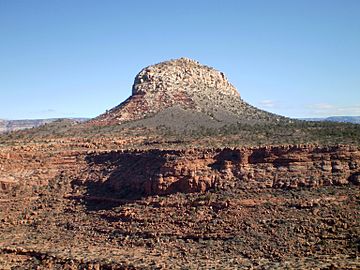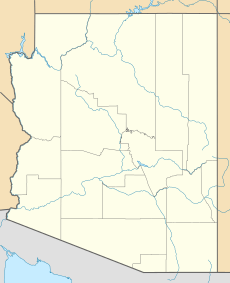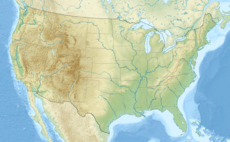Mount Huethawali facts for kids
Quick facts for kids Mount Huethawali |
|
|---|---|

Southwest aspect
|
|
| Highest point | |
| Elevation | 6,281 ft (1,914 m) |
| Prominence | 961 ft (293 m) |
| Isolation | 1.52 mi (2.45 km) |
| Parent peak | Fossil Mountain (6,729 ft) |
| Geography | |
| Location | Grand Canyon National Park Coconino County, Arizona, US |
| Parent range | Coconino Plateau Colorado Plateau |
| Topo map | USGS Explorers Monument |
| Type of rock | sandstone, siltstone, mudstone |
| Climbing | |
| First ascent | 1898 |
| Easiest route | class 3 scrambling SW slope |
Mount Huethawali is a tall mountain peak in the Grand Canyon in Arizona, USA. It stands 6,281 feet (1,914 meters) high. This amazing peak is found in Coconino County.
Mount Huethawali is located near other famous spots. It is about 3.5 miles east of Explorers Monument. The peak is also 1.5 miles west of Grand Scenic Divide. It sits right southwest of Huxley Terrace.
This mountain is surrounded by Garnet, Evolution, and Bass Canyons. Mount Huethawali rises over 800 feet (245 meters) above Darwin Plateau. It is also more than 4,000 feet higher than the nearby Colorado River.
Contents
Geology of Mount Huethawali
The top part of Mount Huethawali is made of cream-colored rock. This rock is called Permian Coconino Sandstone. This sandstone layer is the third-youngest rock layer in the Grand Canyon. It formed about 265 million years ago from ancient sand dunes.
Below the Coconino Sandstone, you can find reddish, sloped rock. This layer is called the Permian Hermit Formation. Underneath that is the Pennsylvanian-Permian Supai Group.
Even further down are layers of cliff-forming rock. These include the Mississippian Redwall Limestone and the Cambrian Tonto Group. At the very bottom, near the river, is the Proterozoic Unkar Group.
Climate Around Mount Huethawali
Mount Huethawali is in a cold semi-arid climate zone. This means the area gets very little rain. It also has hot summers and cold winters.
History of Mount Huethawali
The first people to climb Mount Huethawali reached the top in August 1898. These climbers were William Wallace Bass and George Wharton James. James first called the peak Mount Observation.
However, James also wrote that local Native Americans called it "Hue-tha-wa-li." This name is pronounced "we-the-wally." It means "White Rock Mountain." Some people believe "Huethawali" means "observation point." Others say it means "white tower" or "white rock mountain" in the Havasupai language.
The name "Huethawali" was officially chosen in 1932. The U.S. Board on Geographic Names made this decision.
Gallery








